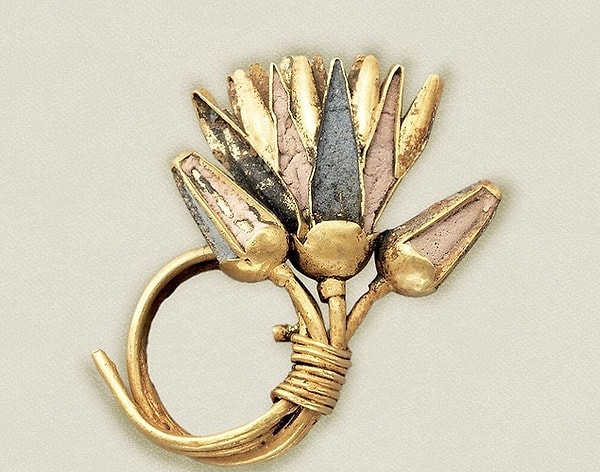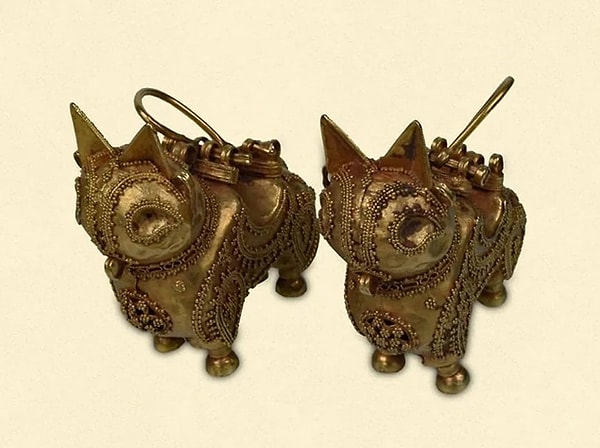Ancient Jewelry of Anatolia: Gold, Stone, and Silver Through the Ages
What makes jewellery made of gold, silver, and precious stones truly valuable is the historical heritage they carry. These ancient pieces of jewellery, which may have belonged to a ruler or a peasant girl's dowry, carry the traces of the past into the present. So, what are the best historical artefacts in Turkey? Where are the best museums in Turkey? Let us take a look at some of the most impressive examples of ancient jewellery on display in Turkey's rich museum collections.👇
1. Kaman Kalehöyük Archaeology Museum

With the advancement of the Bronze Age, the discovery of bronze, an alloy of copper and tin, revolutionised jewellery making. With this development, gold and decorative stones began to be used more frequently in jewellery. The example of the earring, which reflects the artistic sensibilities of the period, bears traces of high craftsmanship. Be sure to visit the Kaman Kalehöyük Archaeology Museum to see this and similar works.
2. Niğde Museum

The necklace in the photo dates back to the Neolithic Period, when people transitioned to a settled lifestyle. This necklace demonstrates how the people of that period created elegant jewellery using materials obtained from nature and developed an advanced aesthetic sense. For more, head to the Niğde Museum.
3. Van Museum

The Urartu Kingdom, one of the powerful civilisations of the Near East, was exceptionally rich in terms of art and culture. For the Urartians, who skillfully worked the mineral deposits found in their geography, jewellery was not only decoration but also a symbol of wealth, luck, fertility, and social status. You can visit the Van Museum to see this impressive piece and other examples of Urartu art.
4. Çorum Museum

The Hittites, one of Anatolia's ancient civilisations, produced a wide variety of jewellery in the resource-rich regions where they settled. Hair ornaments, earrings, bracelets, necklaces, and rings are just a few of the many types of jewellery that showcase their mastery in the field of art. The piece in the photo highlights the delicate craftsmanship of Hittite handicrafts. The Çorum Museum invites you to see this unique piece in person.
5. Uşak Museum

Like the Hittites, the Lydians, one of the oldest civilisations in Anatolia, also left a significant mark in the field of art. One of the most striking legacies of this civilisation, famous for its wealth, is the Karun Treasure. These enchanting jewellery pieces, believed to have belonged to Lydian King Croesus, are on display at the Uşak Museum, bringing visitors face-to-face with the splendour of the past.
6. Samsun Museum

The Pontus Empire, which ruled the Black Sea coast during the Hellenistic Period, left behind magnificent legacies. One of these legacies, the Amesos Treasures, is a rich collection of gold jewellery, glass, and marble artefacts. The jewellery in the photo clearly reflects the empire's wealth and fine craftsmanship. You can visit the Samsun Museum to see the other pieces up close.
7. Kars Museum

The Ani Archaeological Site, a medieval Silk Road settlement, showcases all the richness of the period in terms of urban planning and art. The gold earring in the photo is a unique reflection of this cultural diversity and artistic heritage. This piece, which stands out for its elegant craftsmanship, is currently on display at the Kars Museum.
8. Çorum Museum

Another striking Hittite artefact, this bracelet stands out for both its craftsmanship and its symbolic meaning. The motif on it depicts a ritual scene where the Hittite king offers a sacrifice to the goddess Sauska. This piece, where fashion and lifestyle intertwine, is part of the Çorum Museum's impressive collection.
9. Troya Museum

The collection, known as the “workers' treasures,” which was unearthed during the Troy excavations, includes 24 pieces of gold jewellery that were brought to Turkey in 2012 through diplomatic channels from the University of Pennsylvania Museum of Archaeology and Anthropology in the US. These pieces of jewellery reflect the elegance of the women of Troy and the artistic sensibilities of the period. The Trojan Treasure section is one of the most striking corners of the Troy Museum, which has won international awards.
10. Museum of Anatolian Civilisations

One of Turkey's most important museums, the Anatolian Civilisations Museum, displays many pieces of jewellery that bear the traces of the past. Among these, one of the most striking is a gold-woven necklace with a Medusa head from the Hellenistic period. Visitors encounter the elegance of the past as they explore the museum's exhibition halls to view this impressive piece.
Keşfet ile ziyaret ettiğin tüm kategorileri tek akışta gör!

Send Comment